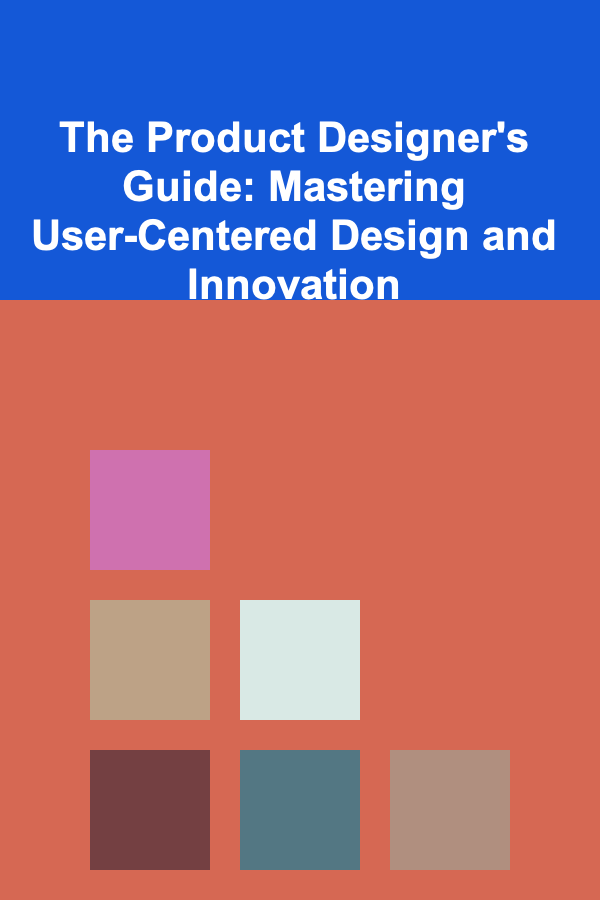
The Product Designer's Guide: Mastering User-Centered Design and Innovation
ebook include PDF & Audio bundle (Micro Guide)
$12.99$10.99
Limited Time Offer! Order within the next:

In today's ever-evolving digital landscape, product design has become more important than ever. As companies strive to stay competitive and deliver value, the role of a product designer is pivotal in ensuring that products not only meet user needs but also push the boundaries of innovation. User-Centered Design (UCD) is at the core of this process, allowing designers to craft intuitive, user-friendly, and highly effective products.
This guide will dive deep into the principles of user-centered design, how to implement them effectively, and how to foster a culture of innovation in your design process. Whether you're a novice or an experienced designer, this comprehensive exploration will provide actionable insights to help you create products that resonate with users while pushing the envelope of creativity.
Understanding User-Centered Design (UCD)
User-Centered Design (UCD) is a design philosophy that prioritizes the needs, behaviors, and feedback of users at every stage of the design process. Rather than focusing solely on technical specifications or business goals, UCD places users at the center, ensuring that every decision is made with their best interests in mind.
Key Principles of UCD
-
Empathy for Users: The foundation of UCD is understanding users. This requires more than just gathering data; it involves deeply empathizing with users, understanding their pain points, and striving to make their lives better through design.
-
Iteration and Feedback: UCD encourages constant iteration. Designers should not assume they know what users want or need; instead, they should prototype, test, and refine designs based on real user feedback.
-
Multidisciplinary Collaboration: UCD isn't a one-person job. It requires close collaboration between product managers, developers, marketers, and the users themselves to ensure the product is well-rounded and user-friendly.
-
Incorporation of Real-World Context: UCD emphasizes understanding users in their natural environment, taking into account factors such as location, device use, and real-world constraints when designing solutions.
Why UCD Matters
By focusing on the needs of the user, UCD reduces the risk of product failure. It helps create designs that are intuitive, effective, and valuable. Products that stem from a UCD approach are more likely to delight users, gain higher user adoption, and generate positive feedback.
The UCD Process: A Step-by-Step Guide
The process of User-Centered Design can be broken down into several phases, each playing a crucial role in developing products that are both functional and innovative. While these phases are iterative and overlapping, they provide a structured approach to designing with the user in mind.
1. Research and Discovery
A. Understand User Needs
Before designing anything, it's vital to understand who your users are, what problems they are facing, and how your product can address those issues. This stage involves:
- User Interviews: Direct interviews with potential users to gather insights into their pain points, goals, and preferences.
- Surveys: Quantitative data collection to understand user demographics, behaviors, and needs on a broader scale.
- Persona Creation: Developing user personas based on research to represent key user groups and guide design decisions.
B. Market and Competitor Analysis
Look at the competitive landscape to see how existing products address user needs and where there are gaps in the market. Analyzing competitors helps you avoid reinventing the wheel while identifying opportunities for innovation.
C. Define Problems and Opportunities
By synthesizing research data, you can clearly define the problem you are solving and uncover opportunities for innovation. This step ensures the product is designed with a clear purpose and that it truly addresses user pain points.
2. Ideation and Concept Development
A. Brainstorming Solutions
Once you understand the problem, it's time to brainstorm solutions. This is a creative process where you should allow all ideas, big and small, to surface. Consider using methods like:
- Sketching: Quickly visualizing ideas to see how they might take shape.
- Mind Mapping: Mapping out concepts and how they relate to each other.
- Storyboarding: Visualizing user interactions and how your product fits into their daily life.
B. Prototyping
The goal of prototyping is to bring ideas to life quickly and cheaply so they can be tested and iterated. These prototypes can be:
- Low-fidelity (Wireframes): Simple sketches or wireframes that communicate layout and interaction flow without focusing on visual design.
- High-fidelity (Interactive Prototypes): Detailed, interactive versions of your product that simulate real-world use.
Prototyping allows you to validate ideas early and make adjustments based on feedback.
3. Testing and Validation
A. Usability Testing
Usability testing is the heart of the UCD process. By observing real users interact with prototypes, you can identify usability issues, misconceptions, or areas of confusion.
- Conduct User Tests: Have users complete tasks with your prototype, observing where they struggle and what needs improvement.
- Collect Feedback: Ask open-ended questions to gain insights into users' experiences, preferences, and frustrations.
B. Iteration
Based on the feedback from testing, make adjustments to your design. This may involve:
- Refining user flows.
- Simplifying complex features.
- Adding or removing features based on user needs.
This phase may be repeated multiple times, continuously refining the product until it meets user expectations.
4. Implementation and Launch
Once the design is refined, the next phase is collaborating with developers to bring the product to life. This phase involves:
- Design Handoff: Providing developers with detailed design specifications, assets, and user flow documentation.
- Development Support: Collaborating closely with the development team to ensure the product is built according to the design specifications.
- Launch: Once the product is built, launch it to users. Ensure there's a plan in place for monitoring user interactions and collecting post-launch feedback.
5. Post-Launch Evaluation and Maintenance
After the product is launched, the UCD process doesn't stop. Constantly gathering user feedback and analyzing how the product is used in the real world will inform future iterations and updates.
- User Analytics: Use analytics tools to track user engagement, retention, and behavior patterns.
- Continuous Improvement: Based on analytics and feedback, continue to refine the product to better meet user needs and expectations.
Fostering a Culture of Innovation in Product Design
Innovation is a key aspect of product design, and it goes hand-in-hand with user-centered principles. To stay ahead of the competition, product designers must constantly challenge themselves and their teams to think creatively and push the boundaries.
1. Encouraging Cross-Disciplinary Collaboration
Innovation often comes from combining insights from different disciplines. By collaborating with developers, marketers, and even customers, designers can uncover new opportunities and perspectives. Encourage open communication and create an environment where new ideas are valued.
2. Embrace Failure as Learning
Innovation involves taking risks, and not all ideas will succeed. It's essential to create a safe space for experimentation and failure. Learn from mistakes, iterate on ideas, and use failures as stepping stones toward improvement.
3. Continuous Learning and Development
Product designers should never stop learning. The design field is constantly evolving, with new tools, methodologies, and best practices emerging all the time. Attend workshops, read design books, and stay updated on industry trends to keep your skills sharp and your creativity flowing.
4. Create a Design System
A design system is a collection of reusable components and patterns that ensure consistency and efficiency across design work. A well-structured design system enables faster prototyping and iterative improvements, allowing designers to focus more on innovation rather than reinventing common design elements.
Conclusion: The Path to Great Product Design
Mastering user-centered design requires patience, empathy, and a commitment to continuous learning. By following the UCD process, product designers can ensure they are creating products that not only meet user needs but also deliver a memorable, engaging, and innovative experience.
Remember, great design isn't just about solving problems---it's about improving lives. By staying connected to users, embracing feedback, and fostering a culture of innovation, you can create products that truly make a difference in the world.
Reading More From Our Other Websites
- [Digital Decluttering Tip 101] Digital Minimalism: Reducing Screen Noise and App Overload
- [Home Holiday Decoration 101] How to Decorate a Holiday Mantel Like a Pro
- [Organization Tip 101] How to Use Concrete Stains to Create Unique and Customized Floor Designs
- [Home Staging 101] How to Maximize the Impact of Professional Home Staging Services
- [Whitewater Rafting Tip 101] Essential Rafting Gear: What Every Beginner Needs
- [Home Budget 101] How to Create a Monthly Budget That Works for Your Home Finances
- [Personal Care Tips 101] How to Choose a Sunscreen for Outdoor Activities
- [Home Space Saving 101] How to Maximize Small Living Room Spaces with Smart Furniture
- [Organization Tip 101] Why Organizing Your Finances Leads to Better Budgeting
- [Home Maintenance 101] How to Inspect and Maintain Your Home's Foundation for Cracks

How to Create a Lease Agreement That Protects Both Parties
Read More
How To Discover Trailblazing Female Rock Musicians
Read More
How to Navigate Financial Planning for a Single-Income Household
Read More
How to Store Essential Oils with Children or Pets at Home
Read More
Lowering Student Loan Interest Rates Through Refinancing: When Is the Right Time?
Read More
How to Handle Unexpected Issues in Your Bachelor Party Checklist
Read MoreOther Products

How to Create a Lease Agreement That Protects Both Parties
Read More
How To Discover Trailblazing Female Rock Musicians
Read More
How to Navigate Financial Planning for a Single-Income Household
Read More
How to Store Essential Oils with Children or Pets at Home
Read More
Lowering Student Loan Interest Rates Through Refinancing: When Is the Right Time?
Read More